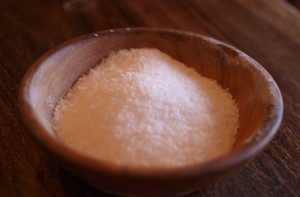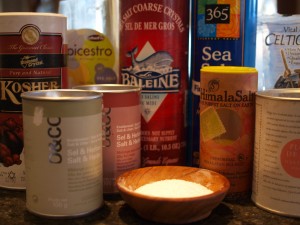 So, what exactly is a “pinch of salt?” Anyone who reads this blog has every reason to ask this question and wonder why my recipes almost always call for such an incredibly vague measurement. I know it can be annoying, especially if you have a salt shaker sitting next to your stove.
So, what exactly is a “pinch of salt?” Anyone who reads this blog has every reason to ask this question and wonder why my recipes almost always call for such an incredibly vague measurement. I know it can be annoying, especially if you have a salt shaker sitting next to your stove.
So I wanted to use this post to address a few salt-related issues, one of which is how to measure a “pinch.”
But first let’s talk about salt in general. It’s probably not shocking to learn that Americans eat too much salt. According to the Institute of Medicine, the human body needs about 1,500 mg. of sodium per day to regulate its fluids (salt’s primary job). Current U.S. dietary guidelines call for a maximum of 2,300 mg. per day, and even less for older people (over 51), African Americans, and people with diabetes, high blood pressure, and kidney disease. Yet, the average American consumes almost 3,500 mg. of sodium per day. Increased sodium levels are linked to obesity, high blood pressure, stroke, cancer, and kidney disease, not to mention fluid retention.
What I did find shocking is that more than three-quarters of that sodium intake is from processed convenience foods and fast food. That shouldn’t really surprise me but it does. Did you know that one measly bean burrito from Taco Bell has 1,080 mg. of sodium? Or that a can of Progresso Chicken Noodle Soup has 1,380? I guess it’s easy to see how those milligrams add up, especially if you throw in some Lay’s potato chips and ranch dressing. Since kids need even less sodium than adults, they can exceed their recommended daily intake in one bowl of Disney Princess soup.
The most obvious way to control your sodium levels is to eat more fresh, simple foods. And the best way to do that is to cook. Which brings me to cooking with salt. I believe that if you mostly cook at home and cut out highly processed foods, it’s okay to use a little salt (assuming you are not on a low-sodium diet or have any of the health problems listed above). Salt enhances the flavor of just about any food and is pretty crucial for making things taste delicious. We just need to learn how to salt right.
 A few years ago I learned that most table salt is highly processed and most of its natural mineral content is removed, plus it’s got added iodine, which the average person’s diet lacked in the early 1900s. While
A few years ago I learned that most table salt is highly processed and most of its natural mineral content is removed, plus it’s got added iodine, which the average person’s diet lacked in the early 1900s. While
sea salt and kosher salt contain the same amount of sodium as table salt (chemically, salt is salt), I’ve found that I need to use less of these coarser, more natural salts to achieve the same level of saltiness. And there is a big difference in taste. I think sea salt has a slightly briny taste that adds more character to food. Plus, I can taste the iodine in iodized salt and don’t really like it; it tastes like chemicals to me. But as anyone who’s browsed the gourmet salt display at Whole Foods knows, the difference in price is huge. While I keep some sea salt on hand (Obviously! My salt collection is kind of ridiculous, huh. I guess I can’t deny I went through a period of serious salt snobbery.), I actually cook with kosher salt, which has larger crystals (like sea salt) and no added chemicals or preservatives. I like its pure salt taste and the fact that it’s about half the price of sea salt. And its texture is perfect for pinching.
Okay, so back to the annoying “pinch of salt” business. I write this in my recipes because I believe it is one of the best ways of controlling the amount of salt in the food you cook — plus, it’s fun and makes mes feel kind of “chef-y.” If you shake salt from a shaker, you really can’t tell how much you’re adding. When a recipe calls for salt, no matter the amount, I always start with a pinch between my middle finger and thumb (which I’d guess measures about 1/4 teaspoon). Once I’ve added that, I taste the food to see if it needs more then repeat if necessary. Sometimes a recipe will call for a lot of salt — like 2 tablespoons — and I’ve ended up really only needing about two or three pinches, so less than half. (Obviously this method doesn’t work for baking — a big part of why I don’t bake very much.)
Tips for keeping the salt under control:
Read ingredient labels on packaged foods. You’ll soon discover that many, if not most, are high in sodium. This is generally because processing food (food that’s probably not the peak of freshness and quality to begin with) takes away taste. So, to make their food more palatable, food companies have to add a lot of salt. Eat fresh, whole foods instead whenever possible.
Slightly under-salt hot food. Sometimes the high temperature masks the saltiness, and the food ends up tasting overly salty once it cools. The old adage that you can always add more salt but you can’t take it out is very true. Properly seasoned food will taste flavorful; if it tastes salty, it’s over-salted.
Don’t use salted butter or other condiments. This includes garlic salt. You want to be able to control your salt levels, so always cook with unsalted butter, garlic powder (or, better, fresh garlic), etc.
Make your own salad dressing. Not only will you reduce sodium, you’ll also avoid about 25 other unpronounceable ingredients in an item that should only contain three things.
Season foods with bold-tasting things like vinegar, garlic, spices, lemon, herbs, and onions. You’ll need less salt and still have strong flavors. I add a splash of vinegar to almost everything I make.
Taste and check seasoning levels as you cook. This can help you avoid over-seasoning. Obviously, don’t add salt to something that doesn’t need it; for instance, dishes with aged cheeses like Parmesan can be plenty salty without any added salt.
Cook with large-grained, un-iodized salt. I really think you’ll use less due to the purer salt taste. I recommend Diamond Crystal kosher salt.
Pinch, don’t shake, salt when cooking. If you don’t have a shallow salt dish or cellar, it’s worth getting one and keeping it next to your stove.
Save the pricey sea salt for finishing food. Try a few of the different varieties to find the ones you love and sprinkle a bit on your food before serving. Think of sea salt almost as a crunchy topping, and a little goes a very long way.
